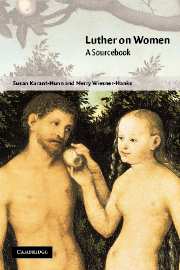1 - Introduction
Published online by Cambridge University Press: 05 June 2012
Summary
It is hard to imagine that any aspect of Martin Luther's ideas or life is understudied. There are countless biographies in many languages, specialized analyses of his ideas about various theological, political, and intellectual topics, and journals and book series devoted completely to him. The five-hundredth anniversary of his birth in 1983 saw academic conferences and church-sponsored lectures all over the world, and interest in his ideas and the Protestant Reformation that resulted in part from them shows no signs of abating.
It is also hard to imagine, given the last twenty-five years of women's history, that the ideas of a man who wrote so much about women and who was so clearly influential would not have been analyzed to death. Educated men's ideas about women are one of the easiest things to investigate when exploring the experience of women in any culture, as they are more likely to be recorded than women's own ideas. For someone who lived, as Luther did, after the invention of the printing press, they might also be published and so widely available, not simply found in a single private letter or archival record. The sixteenth century was a period when men – and a few women – argued often in print about the nature of women, whether they were good or bad, human or not human, whether they had reason or were governed by their passions.
- Type
- Chapter
- Information
- Luther on WomenA Sourcebook, pp. 1 - 14Publisher: Cambridge University PressPrint publication year: 2003

